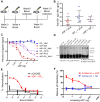Antigenic subversion: a novel mechanism of host immune evasion by Ebola virus
- PMID: 23271969
- PMCID: PMC3521666
- DOI: 10.1371/journal.ppat.1003065
Antigenic subversion: a novel mechanism of host immune evasion by Ebola virus
Abstract
In addition to its surface glycoprotein (GP(1,2)), Ebola virus (EBOV) directs the production of large quantities of a truncated glycoprotein isoform (sGP) that is secreted into the extracellular space. The generation of secreted antigens has been studied in several viruses and suggested as a mechanism of host immune evasion through absorption of antibodies and interference with antibody-mediated clearance. However such a role has not been conclusively determined for the Ebola virus sGP. In this study, we immunized mice with DNA constructs expressing GP(1,2) and/or sGP, and demonstrate that sGP can efficiently compete for anti-GP(12) antibodies, but only from mice that have been immunized by sGP. We term this phenomenon "antigenic subversion", and propose a model whereby sGP redirects the host antibody response to focus on epitopes which it shares with membrane-bound GP(1,2), thereby allowing it to absorb anti-GP(1,2) antibodies. Unexpectedly, we found that sGP can also subvert a previously immunized host's anti-GP(1,2) response resulting in strong cross-reactivity with sGP. This finding is particularly relevant to EBOV vaccinology since it underscores the importance of eliciting robust immunity that is sufficient to rapidly clear an infection before antigenic subversion can occur. Antigenic subversion represents a novel virus escape strategy that likely helps EBOV evade host immunity, and may represent an important obstacle to EBOV vaccine design.
Conflict of interest statement
The authors have declared that no competing interests exist.
Figures








Comment in
-
A novel mechanism of immune evasion mediated by Ebola virus soluble glycoprotein.Expert Rev Anti Infect Ther. 2013 May;11(5):475-8. doi: 10.1586/eri.13.30. Expert Rev Anti Infect Ther. 2013. PMID: 23627853
References
-
- Leroy EM, Epelboin A, Mondonge V, Pourrut X, Gonzalez JP, et al. (2009) Human Ebola outbreak resulting from direct exposure to fruit bats in Luebo, Democratic Republic of Congo, 2007. Vector Borne Zoonotic Dis 9: 723–728. - PubMed
Publication types
MeSH terms
Substances
Grants and funding
LinkOut - more resources
Full Text Sources
Medical

